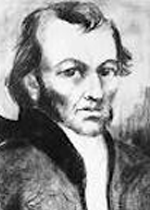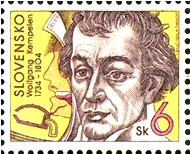Kempelen Farkas (1734 – 1804)
 A Hungarian who was more commonly known by the German version of his name, Wolfgang von Kempelen. Kempelen invented the first chess-playing ‘automation’ and was extremely proud of the mechanism which controlled its arm, which later became of major importance in prosthetics. It was originally created as an amusement tool for the court of the Empress Maria Theresa. The device consisted of a life-size figure, clad in Turkish robes, attached to a large cabinet or chest. The cabinet was divided into two compartments and a sliding drawer; it had a chessboard inlaid on its upper surface. At the start of an exhibition, the interior structure of the cabinet and the figure, containing a bewildering array of machinery, would be displayed to the spectators who were invited to confirm that the machine operated without help from any human interference. After the doors and panels had been closed, members of the audience would play chess against the automation who usually won with ease. In fact “The Turk”, as it was called, was a complicated hoax because it had a strong human player concealed within the cabinet. A detailed account of the mechanics of the illusion can be found in a series of articles by K. Harkness and J.S. Battell published in
A Hungarian who was more commonly known by the German version of his name, Wolfgang von Kempelen. Kempelen invented the first chess-playing ‘automation’ and was extremely proud of the mechanism which controlled its arm, which later became of major importance in prosthetics. It was originally created as an amusement tool for the court of the Empress Maria Theresa. The device consisted of a life-size figure, clad in Turkish robes, attached to a large cabinet or chest. The cabinet was divided into two compartments and a sliding drawer; it had a chessboard inlaid on its upper surface. At the start of an exhibition, the interior structure of the cabinet and the figure, containing a bewildering array of machinery, would be displayed to the spectators who were invited to confirm that the machine operated without help from any human interference. After the doors and panels had been closed, members of the audience would play chess against the automation who usually won with ease. In fact “The Turk”, as it was called, was a complicated hoax because it had a strong human player concealed within the cabinet. A detailed account of the mechanics of the illusion can be found in a series of articles by K. Harkness and J.S. Battell published in
Kempelen invented the first chess-playing ‘automation’ and was extremely proud of the mechanism which controlled its arm, which later became of major importance in prosthetics. It was originally created as an amusement tool for the court of the Empress Maria Theresa. The device consisted of a life-size figure, clad in Turkish robes, attached to a large cabinet or chest. The cabinet was divided into two compartments and a sliding drawer; it had a chessboard inlaid on its upper surface. At the start of an exhibition, the interior structure of the cabinet and the figure, containing a bewildering array of machinery, would be displayed to the spectators who were invited to confirm that the machine operated without help from any human interference. After the doors and panels had been closed, members of the audience would play chess against the automation who usually won with ease. In fact “The Turk”, as it was called, was a complicated hoax because it had a strong human player concealed within the cabinet. A detailed account of the mechanics of the illusion can be found in a series of articles by K. Harkness and J.S. Battell published in
In fact “The Turk”, as it was called, was a complicated hoax because it had a strong human player concealed within the cabinet. A detailed account of the mechanics of the illusion can be found in a series of articles by K. Harkness and J.S. Battell published in Chess Review (1947). The Turk’s first performance took place before the Hapsburg court in Vienna, 1770. Public exhibitions continued intermittently for almost eighty-five years. In 1783-4 Kempelen and his device visited many
The Turk’s first performance took place before the Hapsburg court in Vienna, 1770. Public exhibitions continued intermittently for almost eighty-five years. In 1783-4 Kempelen and his device visited many European cities, including Dresden, Leipzig, Paris, and London. After Kempelen’s death in 1804, the automation was purchased by a Bavarian showman and musician, Johann Nepomuk Maelzel, who had also designed an automatic Beethoven to compose some original music. In 1809, during the Wagram campaign, Napoleon played (unsuccessfully) against The Turk in Vienna. For a period time, The Turk was held in the private collection of Prince Eugene de Beauharnais, who bought its secret for 30,000 francs. However, Maelzel acquired it again in 1817 and toured extensively with the machine in Paris 1918, London 1918-20, Amsterdam 1921-2 and America 1926-36. In 1937 both Maelzel and The Turk’s current operator, Schlumberger (the tutor of Saint-Amant) died of yellow fever while returning from Havana to the USA. The automation ended its days at the Chinese Museum in Philadelphia, where it perished in a fire in 1854. Some of the names of the players who inhabited The Turk’s interior are known. These
The automation ended its days at the Chinese Museum in Philadelphia, where it perished in a fire in 1854. Some of the names of the players who inhabited The Turk’s interior are known. These include Allgaier (1809), Weyle and Alexandre (1918), Boncourt (1818), Lewis (1818-19), Williams (1819), Mouret (1820) and Schlumberger (1826 onwards).
 A counselor at the Austro-Hungarian court and a man of considerable ingenuity, Kempelen invented an extensively practiced method of embossed printing for the blind and also carried out research into mechanical speech, which was studied by the pioneers of telecommunication. He designed the hydraulic system that operated the fountains at Schoenbrunn and a canal system to link Budapest with the Adriatic at Rijeka (Fiume). For his services to the state, he was made a Baron. (source: Oxford Companion of Chess).
A counselor at the Austro-Hungarian court and a man of considerable ingenuity, Kempelen invented an extensively practiced method of embossed printing for the blind and also carried out research into mechanical speech, which was studied by the pioneers of telecommunication. He designed the hydraulic system that operated the fountains at Schoenbrunn and a canal system to link Budapest with the Adriatic at Rijeka (Fiume). For his services to the state, he was made a Baron. (source: Oxford Companion of Chess).



